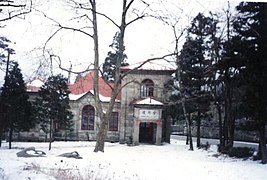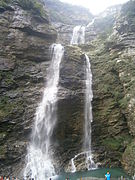geo.wikisort.org - Mountains
Mount Lu or Lushan[1] (simplified Chinese: 庐山; traditional Chinese: 廬山; pinyin: Lúshān, Gan: Lu-san), officially named Mountain Lu National Park, is a mountain in China. It was also known as Kuanglu (匡廬) in ancient times. It is situated in Jiujiang, Jiangxi Province, and is one of the most renowned mountains in the country. Mount Lu is located primarily in Lushan county-level city in Jiujiang Prefecture, although the northern portions are found in Lianxi District which was formerly known as Lushan District and until 2016 covered the majority of the Mount Lu. The oval-shaped mountains are about 25 kilometers (16 mi) long and 10 kilometers (6.2 mi) wide, and neighbors Jiujiang city and the Yangtze River to the north, Nanchang city to the south, and Poyang Lake to the east. Its highest point is Dahanyang Peak (大汉阳峰), reaching 1,474 meters (4,836 ft) above sea level, and is one of the hundreds of steep peaks that towers above a sea of clouds that encompass the mountains for almost 200 days out of the year.
This article needs additional citations for verification. (February 2020) |
| UNESCO World Heritage Site | |
|---|---|
 | |
| Official name | Mountain Lu National Park |
| Location | Jiujiang, Jiangxi, China |
| Criteria | Cultural: (ii), (iii), (iv), (vi) |
| Reference | 778 |
| Inscription | 1996 (20th Session) |
| Area | 282 square kilometers (109 sq mi) |
| Coordinates | 29°26′N 115°52′E |


Mount Lu is known for its grandeur, steepness, and beauty and a prominent tourist attraction, especially during the summer months when the weather is cooler in the mountains than elsewhere. The mountain and the surrounding region is one of the "spiritual centers" of China, containing many Buddhist and Taoist temples in addition to landmarks of Confucianism.[2] Because of its striking beauty and sacred importance, Lushan National Park has been a UNESCO World Heritage Site since 1996.[2] The overlapping Lushan Quaternary Glaciation National Geopark is a member of UNESCO Global Geoparks Network.
History
Lushan contains important sites and temples for Taoism, Buddhism, and Confucianism. Between AD 386 and 402 during the Jin dynasty, Huiyuan founded Pure Land Buddhism and Donglin Temple on the slopes of Lushan.[2] During the Tang dynasty (618–907), Taoist temples were constructed nearby to house sacred scriptures.[2] The White Deer Grotto Academy, founded in AD 940, developed into a renowned center of academic research during the Song dynasty under the direction of Confucian scholar Zhu Xi.[2] The academy was continually open until at least the 19th century. Other important medieval structures on the mountain include the grave of the famous Tang dynasty poet Tao Yuanming and imperial pavilions during the Ming dynasty.
In later years, Lushan was a summer resort for Western missionaries in China. Absalom Sydenstricker, the father of Pearl Buck, was one of the first five missionaries to acquire property in the Kuling Estate on the mountain. The development of Kuling was instigated by the Reverend Edward Little and Dr. Edgerton H. Hart.[3] The four principal founders of the China's Nurses Association and its first president, Caroline Maddock Hart; met in Kuling to form this association.[4]
During the Long March, in early 1935, a battle took place in this area between communist and republican forces, in which Hu Yaobang, later General Secretary of the Communist Party of China, was seriously injured.
Mount Lu was once dubbed the xiadu ("summer capital") of the Republic of China. Chiang Kai-shek, China's leader at the time, would frequently spend his summers here. In June 1937, Zhou Enlai, then a major leader in the Communist Party, met with Chiang on the mountain to discuss a united front against the Japanese invasion. In July 1937, Chiang Kai-shek announced his intention for a full mobilization for war against Japan from Mount Lu. In 1946, following the war, the U.S. special diplomatic mission led by General George C. Marshall met with Chiang Kai-Shek to discuss the role of post-World War II China.
Mao Zedong convened three large conferences of senior party officials at Mount Lu, in 1959, 1961, and 1970. The 1959 conference became known as the Lushan Conference. The meeting saw the purge of decorated Chinese Civil War and Korean War general Peng Dehuai, who was critical of Mao's Great Leap Forward policies. The 1970 Lushan Conference took place during the Cultural Revolution, and marked the increasing antagonism between those loyal to Mao and those loyal to his chosen successor Lin Biao.
Attractions and features
Popular attractions in Mount Lu include the Immortal Caverns (仙人洞), Meilu Outhouse (美庐别墅), Five Old Man Peaks (五老峰), White Deer Cavern Academy (白鹿洞书院), Three Tiled Springs (三叠泉), Luling Lake (芦林湖), Lushan Hot Springs (庐山温泉), Botanical Gardens (植物园), the Bamboo Temple (竹山寺), Guanyin Bridge (观音桥), Peach Blossom Garden (桃花源), Catholic Church of Mount Lu (庐山天主堂),[5] and many more.
- The Lushan Botanical Gardens features tens of thousands of plant species.
- Below the Five Old Men Peak is the White Deer Grotto Academy, named after the poet Li Bo (Chinese: 李渤) (not to be confused with the famous poet Li Bai), who raised white deer there. It is one of the most famous higher learning institutions in ancient China.
- West is the Flower Path which provided inspiration to Bai Juyi, a famous poet who lived during the Tang dynasty.
- Between the Yangtze River and Lake Poyang lie the Greater and Lesser Tianchi Lakes, the Jingxiu Valley, and Lulin Lake. On the north bank of the latter is the Lushan Museum, which features pottery and bronzes dating from various periods of ancient China, as well as calligraphy from the Tang dynasty and paintings from the Ming and Qing dynasties.
- At the centre (between three peaks), and at an altitude of over 1 kilometer above sea level, is the town of Guling, which is linked by a mountain highway to neighboring spots in the region.
- World-famous Lushan Clouds and Mist Tea (simplified Chinese: 庐山云雾茶; traditional Chinese: 廬山云霧茶) is grown in the mountains.
Gallery
- Mountain Immortals Cave
- Old church
- Lake Lulin
- Donglin temple
- White Deer Grotte Academy
- Lofty Mount Lu by Shen Zhou, 1467
- The small peaks of the mountain range can be climbed by visitors.
- Mountain scenery near Sandie spring in Lushan Scenic Area
- Lushan west sea scenery
Climate
| Climate data for Mount Lu (1981–2010) | |||||||||||||
|---|---|---|---|---|---|---|---|---|---|---|---|---|---|
| Month | Jan | Feb | Mar | Apr | May | Jun | Jul | Aug | Sep | Oct | Nov | Dec | Year |
| Record high °C (°F) | 19.4 (66.9) |
20.5 (68.9) |
24.6 (76.3) |
26.4 (79.5) |
28.1 (82.6) |
29.3 (84.7) |
31.8 (89.2) |
31.8 (89.2) |
30.2 (86.4) |
28.5 (83.3) |
25.1 (77.2) |
18.9 (66.0) |
31.8 (89.2) |
| Average high °C (°F) | 4.5 (40.1) |
6.2 (43.2) |
10.2 (50.4) |
16.0 (60.8) |
20.2 (68.4) |
22.9 (73.2) |
25.9 (78.6) |
25.2 (77.4) |
21.4 (70.5) |
16.9 (62.4) |
12.1 (53.8) |
7.2 (45.0) |
15.7 (60.3) |
| Daily mean °C (°F) | 0.5 (32.9) |
2.2 (36.0) |
6.0 (42.8) |
11.9 (53.4) |
16.4 (61.5) |
19.6 (67.3) |
22.5 (72.5) |
21.7 (71.1) |
17.9 (64.2) |
13.1 (55.6) |
8.1 (46.6) |
3.0 (37.4) |
11.9 (53.4) |
| Average low °C (°F) | −2.5 (27.5) |
−0.8 (30.6) |
2.7 (36.9) |
8.6 (47.5) |
13.5 (56.3) |
17.1 (62.8) |
20.2 (68.4) |
19.4 (66.9) |
15.5 (59.9) |
10.3 (50.5) |
5.1 (41.2) |
−0.2 (31.6) |
9.1 (48.3) |
| Record low °C (°F) | −13.6 (7.5) |
−11.6 (11.1) |
−10.4 (13.3) |
−5.1 (22.8) |
1.6 (34.9) |
5.8 (42.4) |
11.9 (53.4) |
12.8 (55.0) |
6.5 (43.7) |
−2.4 (27.7) |
−9.9 (14.2) |
−16.7 (1.9) |
−16.7 (1.9) |
| Average precipitation mm (inches) | 80.8 (3.18) |
96.7 (3.81) |
155.3 (6.11) |
216.7 (8.53) |
253.9 (10.00) |
291.3 (11.47) |
257.1 (10.12) |
258.9 (10.19) |
170.0 (6.69) |
105.0 (4.13) |
88.7 (3.49) |
49.5 (1.95) |
2,023.9 (79.67) |
| Average relative humidity (%) | 72 | 77 | 78 | 78 | 79 | 84 | 83 | 85 | 84 | 76 | 67 | 63 | 77 |
| Source: China Meteorological Data Service Center[6] | |||||||||||||
References
- "庐山风景名胜区 - 中国旅游网". www.ct.cn. Retrieved 2022-10-05.
- "Lushan National Park". UNESCO World Heritage Centre. United Nations Educational, Scientific, and Cultural Organization. Retrieved 4 Apr 2021.
- "The History of Lushan & Kuling" by Stanley Crawford
- "Wuhu Missionaries" by Cathleen Green and Stanley Crawford
- "Mount Lu | China & Asia Cultural Travel". 2017-06-09. Retrieved 2021-08-21.
- 中国地面气候标准值月值(1981-2010) (in Simplified Chinese). China Meteorological Data Service Center. Retrieved 10 October 2019.
На других языках
[de] Lu Shan
Der Lu Shan (chinesisch .mw-parser-output .Hani{font-size:110%}庐山) ist ein Berg auf dem Gebiet der kreisfreien Stadt Lushan der Stadt Jiujiang in der chinesischen Provinz Jiangxi. Er ist einer der berühmtesten Berge in China und wurde von der UNESCO zum Welterbe und zu einem Global Geopark erkoren.[1] Von der chinesischen Regierung wird er mit 5A in die höchste Kategorie touristischer Ziele eingestuft. Besonders gerühmt wird seine Landschaft als großartig (雄), überraschend (奇), gefährlich (险) und schön (秀). Seine vielfältige Landschaft und Schönheit gilt in China unter den berühmten Bergen als unübertroffen (匡庐奇秀甲天下).[2] Bereits seit dem Altertum ist er ein wichtiges touristisches Ziel.- [en] Mount Lu
[es] Monte Lu
El monte Lu o Lu Shan (shan significa monte en idioma mandarín) es una montaña de China, situada a 36 kilómetros al sur de la ciudad de Jiujiang en la provincia de Jiangxi, entre el Yangzi y el lago Poyang. En él se encuentran numerosas riquezas naturales (flora, fauna, geología); además, es un lugar destacado para la historia, la religión, la pintura y la poesía. Todas estas características hicieron que en 1996 la Unesco declarara al parque nacional de Lu Shan Patrimonio de la Humanidad.[1][fr] Mont Lu
Le mont Lu (sinogrammes simplifiés : 庐山 ; sinogrammes traditionnels : 盧山 ; hanyu pinyin : lú shān ; également appelé : Lushan) est une montagne de Chine située à 36 km au sud de la ville de Jiujiang (九江) dans le Jiangxi[1], entre le Chang Jiang et le lac Poyang (鄱陽湖). Renfermant de nombreuses richesses naturelles (flore, faune, géologie), c’est aussi un lieu important pour l'histoire, la religion bouddhiste, la peinture et la poésie. Ces caractéristiques ont valu au parc national du mont Lu son inscription au patrimoine mondial en 1996. Le mont est également le site d'un géoparc de l'Unesco. C'est un haut lieu du tourisme.[it] Monte Lu
Monte Lú (廬山T, 庐山S, anche Lúshān o Monte Lushan) è una montagna della Repubblica Popolare Cinese situata nell'omonimo distretto, a sud della città Jiǔjiāng (九江) nella provincia di Jiangxi (江西, Jiāngxī), vicina al Lago Poyang (鄱阳湖, Póyáng Hú).[ru] Лушань
Лушань (кит. упр. 庐山, пиньинь Lúshān) — горный комплекс и национальный парк Китая площадью ок. 300 км² в провинции Цзянси к югу от Цзюцзяна, рядом с озером Поянху. Объект мирового культурного наследия ЮНЕСКО с 1996 г.Другой контент может иметь иную лицензию. Перед использованием материалов сайта WikiSort.org внимательно изучите правила лицензирования конкретных элементов наполнения сайта.
WikiSort.org - проект по пересортировке и дополнению контента Википедии












